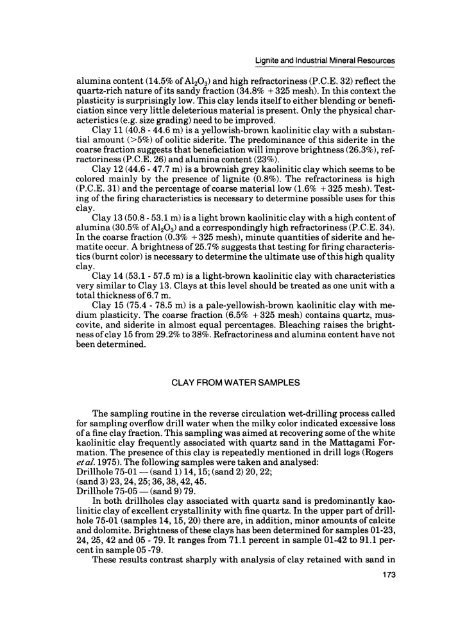Moose River Basin: geology and mineral potential - Geology Ontario
Moose River Basin: geology and mineral potential - Geology Ontario
Moose River Basin: geology and mineral potential - Geology Ontario
You also want an ePaper? Increase the reach of your titles
YUMPU automatically turns print PDFs into web optimized ePapers that Google loves.
Lignite <strong>and</strong> Industrial Mineral Resources<br />
alumina content d.4.5% of A12O3) <strong>and</strong> high refractoriness (P.C.E. 32) reflect the<br />
quartz-rich nature of its s<strong>and</strong>y fraction (34.89fc 4- 325 mesh). In this context the<br />
plasticity is surprisingly low. This clay lends itself to either blending or benefi<br />
ciation since very little deleterious material is present. Only the physical char<br />
acteristics (e.g. size grading) need to be improved.<br />
Clay 11 (40.8 - 44.6 m) is a yellowish-brown kaolinitic clay with a substan<br />
tial amount ^59fc) of oolitic siderite. The predominance of this siderite in the<br />
coarse fraction suggests that beneficiation will improve brightness (26.39fc), ref<br />
ractoriness (P.C.E. 26) <strong>and</strong> alumina content (23^0.<br />
Clay 12 (44.6 - 47.7 m) is a brownish grey kaolinitic clay which seems to be<br />
colored mainly by the presence of lignite (G.8%). The refractoriness is high<br />
(P.C.E. 31) <strong>and</strong> the percentage of coarse material low d.6% 4-325 mesh). Test<br />
ing of the firing characteristics is necessary to determine possible uses for this<br />
clay<br />
Ċlay 13 (50.8 - 53.1 m) is a light brown kaolinitic clay with a high content of<br />
alumina (30.59fc of A12O3) <strong>and</strong> a correspondingly high refractoriness (P.C.E. 34).<br />
In the coarse fraction (Q.3% + 325 mesh), minute quantities of siderite <strong>and</strong> he<br />
matite occur. A brightness of 25.79fc suggests that testing for firing characteris<br />
tics (burnt color) is necessary to determine the ultimate use of this high quality<br />
clay<br />
Ċlay 14 (53.1 - 57.5 m) is a light-brown kaolinitic clay with characteristics<br />
very similar to Clay 13. Clays at this level should be treated as one unit with a<br />
total thickness of 6.7 m.<br />
Clay 15 (75.4 - 78.5 m) is a pale-yellowish-brown kaolinitic clay with me<br />
dium plasticity. The coarse fraction (G.5% -t- 325 mesh) contains quartz, mus<br />
covite, <strong>and</strong> siderite in almost equal percentages. Bleaching raises the bright<br />
ness of clay 15 from 29.29fc to 3S9c. Refractoriness <strong>and</strong> alumina content have not<br />
been determined.<br />
CLAY FROM WATER SAMPLES<br />
The sampling routine in the reverse circulation wet-drilling process called<br />
for sampling overflow drill water when the milky color indicated excessive loss<br />
of a fine clay fraction. This sampling was aimed at recovering some of the white<br />
kaolinitic clay frequently associated with quartz s<strong>and</strong> in the Mattagami For<br />
mation. The presence of this clay is repeatedly mentioned in drill logs (Rogers<br />
etal. 1975). The following samples were taken <strong>and</strong> analysed:<br />
Drillhole 75-01 — (s<strong>and</strong> 1) 14,15; (s<strong>and</strong> 2) 20, 22;<br />
(s<strong>and</strong> 3) 23,24,25; 36,38,42,45.<br />
Drillhole 75-05 — (s<strong>and</strong> 9) 79.<br />
In both drillholes clay associated with quartz s<strong>and</strong> is predominantly kao<br />
linitic clay of excellent crystallinity with fine quartz. In the upper part of drill<br />
hole 75-01 (samples 14,15, 20) there are, in addition, minor amounts of calcite<br />
<strong>and</strong> dolomite. Brightness of these clays has been determined for samples 01-23,<br />
24, 25, 42 <strong>and</strong> 05 - 79. It ranges from 71.1 percent in sample 01-42 to 91.1 per<br />
cent in sample 05 -79.<br />
These results contrast sharply with analysis of clay retained with s<strong>and</strong> in<br />
173

















